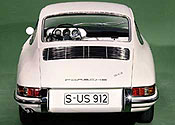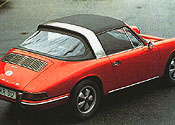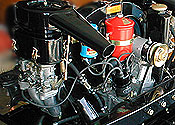



Porsche
912
From
1965 through 1969, Porsche's 912 eased the transition between the 356
and the 911. For those who wanted a new six-cylinder 911 but couldn't
quite afford one, the 912 had the same aerodynamics, ergonomics, style,
and quality of construction. Porsche unveiled the 911 coupe to the public
in 1963, and first offered it for sale in 1964. 912 coupe production commenced
in April 1965. Diehard fans of the 356 could appreciate the 912's proven
356-based flat four-cylinder motor delivering 64 SAE horsepower/ liter.
With the flat-four, an early 912 weighs about 250 pounds less than a standard
911 of the same year. Both 911/912s offered performance with four-wheel
disc brakes, four-wheel independent suspension, rack and pinion steering,
5 speed transmission, and Recaro seats. The 912 won Car and Driver's 1967
"Readers Choice" Poll for its class. With its nimble handling combined
with high reliability, a racing 912 won the European Rally Championship
in 1967.
Overall production gradually shifted from the fuel-efficient 912 to the
higher-horsepower six-cylinder 911. 912s continued in production until
the introduction of the mid-engine 914 and 914-6 in late 1969. Ironically,
after production of the 914 ceased in late 1975, the fuel-injected 912E
model appeared in 1976, powered by a 2.0 liter 914-derived engine. When
912E production ended, Porsche had constructed 34,959 of the Type 912/912E
model. Options included three-point seatbelts, air conditioning, halogen
fog lights, rear window wiper, and electric sunroof. Sunroof coupe 912s
built from 1965-1969 912s are extremely rare. 912s had several components
similar to 356 parts. In addition to its flat-four engine, exterior paint
colors, seats and headrests, chrome wheels, gear shift, instruments, heater
system, aluminum body trim, headlights, fog lights, luggage straps and
mirrors were in the Porsche tradition.
Porsche's Targa assembly line started in December 1966, producing the
first ten 911 Targas, and at least one 912 Targa. 912 Targas cost more
than the coupes, but provided 'air conditioning' without reducing engine
performance. Early factory workshop manuals called the Targa a "cabriolet",
but absent was the fabric top and frame mechanism. Instead, a flat "safety
hoop" rollbar supported both a lift-off folding top, and a separate rear
window. Butzi Porsche decided that the rollbar should be covered with
a brushed stainless steel surface. Factory window tunnel tests demonstrated
that with the top off and rear window up, interior turbulence was low,
even at high speeds. Targas first came equipped with flexible plastic
rear windows ('soft-windows') openable with a zipper; the glass rear window
was an option starting in 1968. Soft-window 912s Targas are extremely
rare. Fixed glass rear window with electric defroster were optional and
became known as the hard-window Targas. Many of the soft-window cars had
been converted to glass over time.
some
info courtesy of 912 registry
912 VIN number sequences
Note: (K) indicates a 912 assembled at the Karmann factory, (P) indicates 912 assembled at the Porsche factory. (Because demand for Porsches exceeded the factory's capacity, Karmann constructed 912s under contract.)
912
production numbers:
6401
in 1965
9090 in 1966 (100,000 Porsche built in 66 was a 912 Targa for the German
Police)
~6300 in 1968
2562 are 912 Targas from 65-69
| Year Mgr. |
Model Year | VIN Coupe (K) |
VIN Coupe (P) |
VIN Targa (P) |
| 65 | 65/66 | 450001- 454470 |
350001- 351970 |
--- |
| 66 | 66 | 454470- 458100 |
351971- 353999 |
|
| 67 | 458101- 461140 |
354001- 354970 |
||
| 67 | 67 | 461141- 463204 |
354971- 355601 |
550001- 550544 |
| 68 | 12800001- 12805598 |
12820001- 12820427 |
12870001- 12871217 |
|
| 68 | ||||
| 69 | 129000001- 12900428(?) |
129020001- 129023450 |
129010001- 129010801 |
|
| 69 | ||||
| 76 | 76 | --- |
9126000001- 9126002099 |
--- |
copyright © 2003-2015 Lüfteknic | privacy | web terms | sale terms | info@lufteknic.com